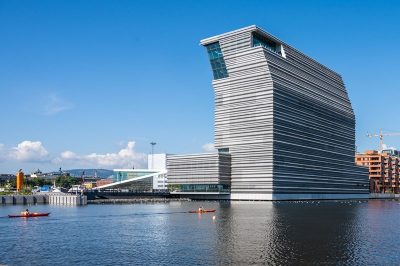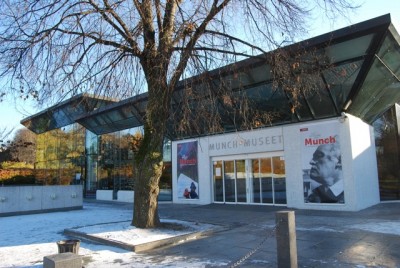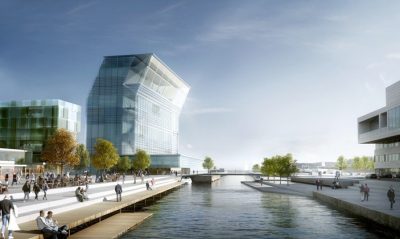NEWS ANALYSIS: Thousands of Norwegians including royalty and top politicians were gathering in Oslo Friday night for the official opening of their new monument to the country’s most famous artist, Edvard Munch. They were all being reminded, meanwhile, of the decades during which Munch’s legacy was neglected, when officials in charge fought over funding and not least the new museum’s location.

It’s been a long rocky road for the museum, now branded simply as MUNCH. It should be noted that the prolific artist himself left his paintings lying on the floor or even outdoors at his home and studio in Oslo’s Ekely district. When he died in 1944, Munch willed his vast personal collection of his own art to the City of Oslo. It including 1,150 paintings, 7,500 drawings and 18,000 graphics plus home furnishings, personal files and other art objects.
The city had a hard time taking care of it all, though, in the post-war years when the need for basic housing was more acute than a museum for Munch’s art. Munch’s legacy wasn’t a high priority, and the city even allowed his home at Ekely, where Munch lived from 1916 to 1944, to be torn down in 1960. Only a side building and its grounds survived in an area that’s now home to an artists’ colony and has been subject its own share of controversy.
The first Munch Museum was finally built in 1963, in the eastside working-class district of Tøyen. It was already too small when it opened, and the vast majority of Munch’s art has remained in storage. City officials were often accused of never providing enough money for necessary maintenance of the building, for neglecting the precious art that was threatened by dampness in the cellar and, again, failing to honour Munch’s legacy.

Security at the old Munch Museum was also woefully inadequate, allowing two masked thieves to run into the museum on a Sunday morning in August 2004 and snatch Munch’s famed paintings The Scream and Madonna. They were later recovered, but it was both embarrassing and somewhat catalytic, finally forcing at least some improvements at the modest building that nonetheless was a major tourist attraction.
Even after oil wealth had started flowing into Norway and Oslo, though, funding for the Munch Museum was precarious and the museum itself started accepting financial assistance from the Japanese oil company Idemitsu. It’s still a sponsor, along with some other oil, shipping and other firms, making some wonder how that squares with Munch’s famous Skrik/Scream about angst and concern for the nature. Art from the private collection of the wealthy former hedgefund founder Nicolai Tangen, who now runs Norway’s huge Oil Fund, is also included in opening exhibits, along with art from one of the museum’s other wealthy sponsors, businessman Stein Erik Hagen.
Finally, after years of political debate and even an unusual torchlit protest march in 2012, most city politicians except those from the conservative Progress Party agreed to stop quarreling and start building. In the end, the location of a new museum had become the biggest source of conflict. Many were keen on improving and expanding its existing site in an area otherwise viewed as downtrodden and needing an attraction like the Munch Museum. Others rallied for the waterfront site at the redeveloping Bjørvika, and won in the end.
The Spanish firm Herreros Architects won the design competition with a high-rise museum known as Lambda and in the spring of 2013, the city approved construction of a new Munch Museum on a redeveloped waterfront site just next door to the Opera House that opened in 2008.

There were still lots of political hiccups along the way, not least over the project’s budget, but the museum won majority support from the public and was expected to open in 2018. Site preparation began in 2015, when a new Labour-led government won control of the city government, but then more delays popped up over demands for new cost evaluations and some politicians still thought the old museum at Tøyen should simply be expanded instead.
It wasn’t until 2016 that the project finally won the essential political green light, with a budget of around NOK 2.7 billion. Crown Princess Mette-Marit laid the museum’s cornerstone in October that year, the museum quickly began to rise and a new opening date was set for 2020. Then came problems and delays with getting its indoor climate system and security doors to function properly and a pre-summer opening was postponed until last autumn.
The Corona pandemic spoiled that, too, but now, five years after the cornerstone ceremony, the public can finally get in to see Oslo’s new landmark. Weekend festivities were due to begin with ceremonies outdoors that will include King Harald V and Queen Sonja, the head of Oslo’s city government Raymond Johansen, the mayor and lots of other “prominent guests.” Up to 7,000 people will be ushered inside during the course of the evening, and a total of 20,000 through the opening weekend.
Johansen seemed keen on overlooking MUNCH‘s troubled past. He has acknowledged that Munch’s decision to will his art collection to the city is “the largest and most important gift Oslo has received,” and that such a gift demands “great responsibility” because it was “a gift to us all.” He went on to tell newspaper Dagsavisen last month, however, that “we managed it well at Tøyen, and now we have built a whole new house for Munch here in Bjørvika,” glossing over all the trouble along the way and what many claim were years of irresponsibility.
MUNCH director Stein Olav Henrichsen was also looking forward, after keeping the old Munch Museum going for years despite funding uncertainty. “This is a big day for us,” he told reporters at a press preview of the new museum on Wednesday. He praised the patience and cooperation he and his staff had with architect Juan Herreros, who’s also in Oslo for the opening and stresses MUNCH “is not only a museum of art,” rather “an instrument” for social interaction. He called it a “symbol” that’s part of Norway’s new skyline. It will be open seven days a week, often late into the evening.
newsinenglish.no/Nina Berglund

